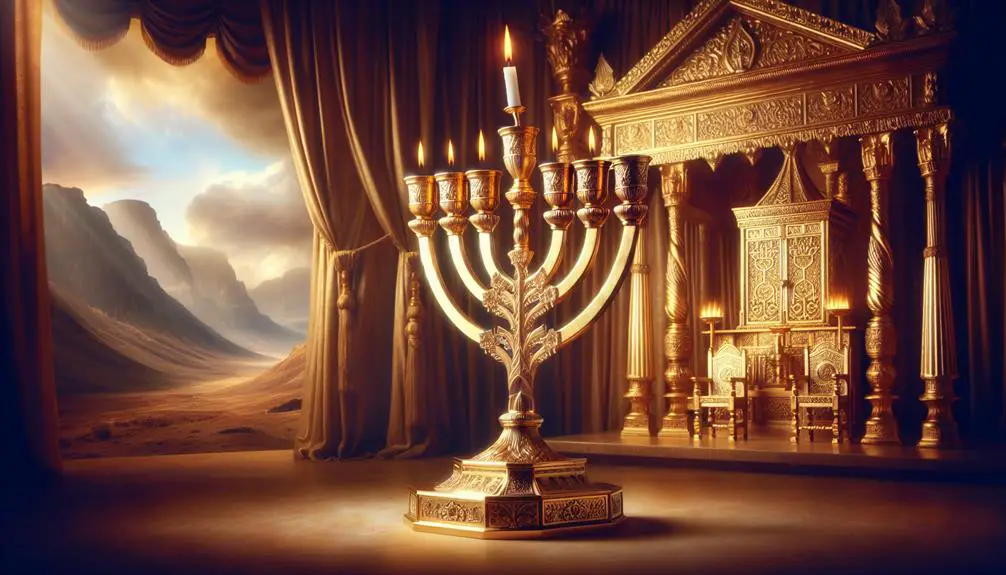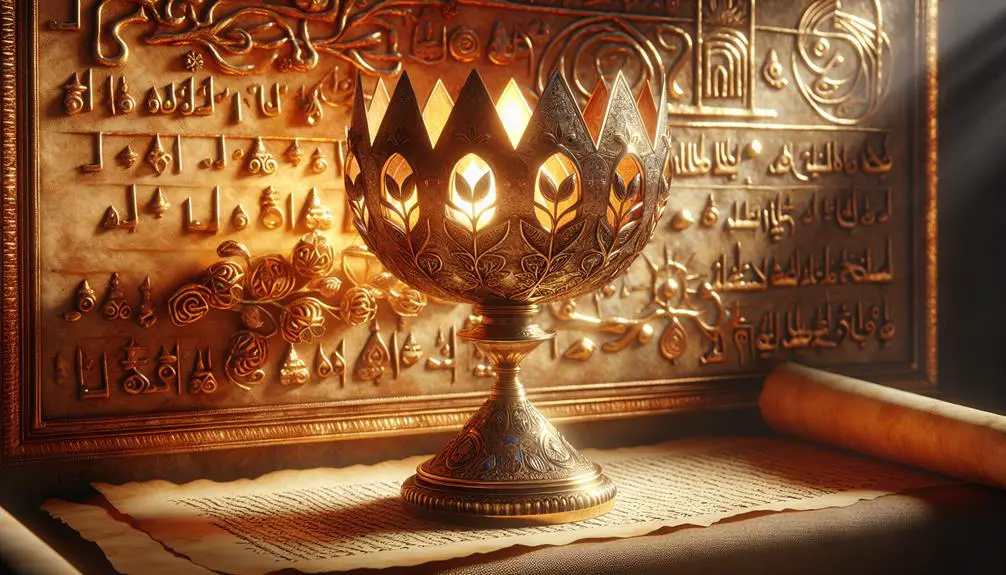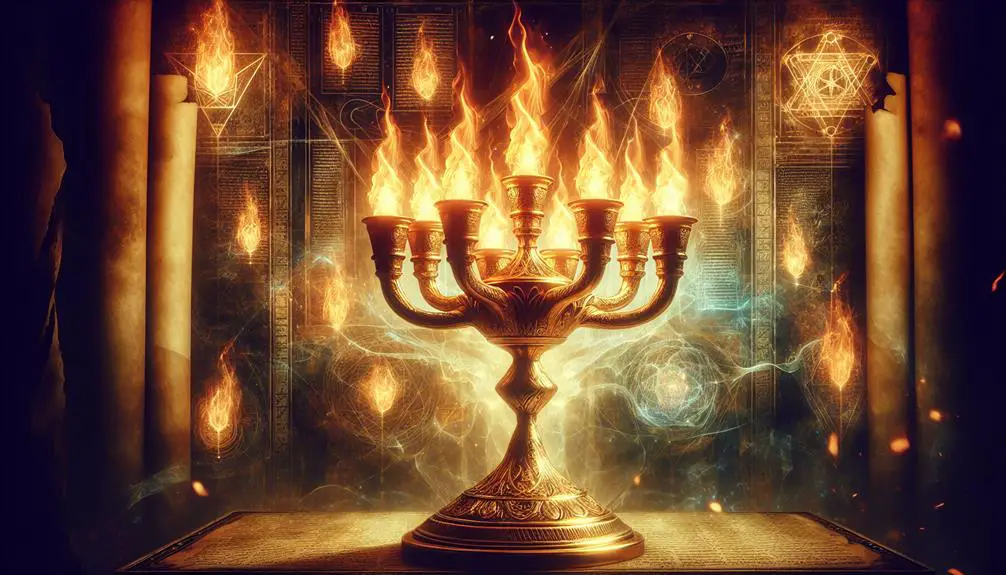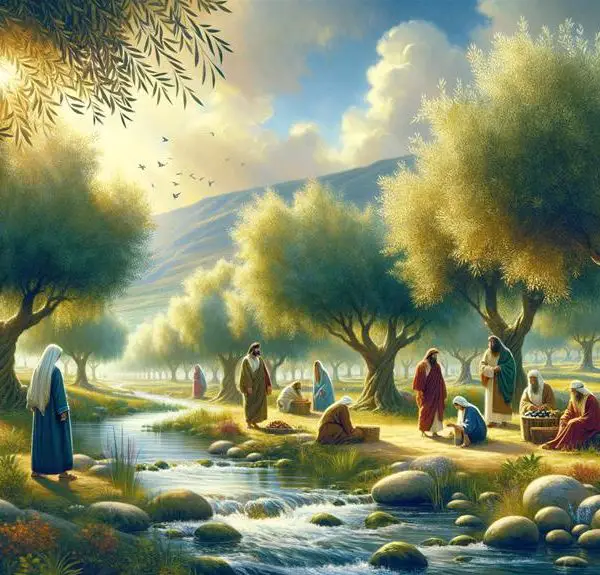Unlock the deep symbolism of the biblical lampstand, where ancient rituals illuminate modern spiritual journeys.

Lampstand in the Bible Meaning
In the vast tapestry of biblical texts, the lampstand isn't just a relic of ancient worship but a beacon that illuminates the path from historical rituals to spiritual truths.
You'll find its roots deeply embedded in the fabric of tabernacle worship, where it stood not merely as an object, but as a symbol of divine presence and guidance.
As you explore its intricate design and the divine instructions surrounding it, you'll uncover layers of meaning that resonate beyond its physical form, touching on themes of enlightenment, tradition, and contemporary relevance.
There's a rich narrative waiting for you to uncover, one that bridges the gap between ancient symbols and their enduring significance in today's world.
Key Takeaways
- The lampstand symbolizes divine presence, guidance, and the pursuit of holiness in biblical texts.
- Its design and material reflect ancient Near Eastern traditions and the interconnectedness of societies.
- In religious traditions, the lampstand is central to Hanukkah and represents Jesus as the 'Light of the World' in Christianity.
- The lampstand's contemporary relevance includes lessons on personal growth, community, and its incorporation into diverse rituals and art forms.
Historical Context and Origin

To understand the significance of the lampstand in biblical narratives, it's essential to delve into its historical context and origins, rooted deeply in ancient Near Eastern traditions and religious practices. The lampstand, or menorah, isn't merely a fixture of light; it's a complex symbol shaped by material variations and geographical influences that reveal much about the cultural and religious milieu of the time.
Material variations in lampstands, ranging from gold to bronze, reflect not only the wealth and status of their owners but also the technological capabilities and artistic preferences of different periods and regions. Gold, used in the construction of the Tabernacle's menorah, signifies its sacredness and the importance placed on craftsmanship and beauty in worship settings.
Geographical influences also played a pivotal role in the design and function of lampstands. The adoption and adaptation of lampstand motifs across different cultures highlight the interconnectedness of ancient Near Eastern societies. These influences can be seen in the convergence of design elements, where local artistic traditions merge with foreign ones, creating objects of profound religious and cultural significance.
Understanding these aspects sheds light on the lampstand's role beyond its immediate liturgical function, encompassing broader themes of identity, exchange, and spirituality in the ancient world.
Symbolism in Tabernacle Worship

Having explored the material and geographical aspects shaping the lampstand's significance, we now turn our attention to its symbolic role within Tabernacle worship. The Tabernacle, a portable earthly dwelling place for the Divine, employed symbols to convey spiritual truths. Among these, the lampstand stood as a beacon of enlightenment, illuminating the path to divine wisdom. Its light was not merely physical but represented the eternal presence of God guiding His people.
The symbolism extended to priestly garments and sacrificial rituals, each element meticulously designed to reflect aspects of atonement, sanctity, and divine service. Priestly garments, for instance, were not just attire but embodied holiness and the mediatory role of priests. Similarly, sacrificial rituals underscored the concept of substitutionary atonement, a pivotal tenet in understanding sin, forgiveness, and reconciliation with God.
To better grasp the intricate symbolism, consider the table below:
Symbol |
Represents |
Significance |
|---|---|---|
Light |
Divine Presence |
Guidance and purity |
Priestly Garments |
Holiness |
Mediation between God and people |
Sacrificial Rituals |
Atonement |
Reconciliation and forgiveness |
Altar |
Sacrifice |
Devotion and worship |
Incense |
Prayer |
Communication with the Divine |
These elements collectively reinforced the Tabernacle's role as a microcosm of divine-human interaction, emphasizing the importance of worship, obedience, and the pursuit of holiness.
Design and Divine Instructions

As we delve into the design and divine instructions of the Tabernacle, it's crucial to understand that every detail was meticulously prescribed to serve a specific symbolic purpose. The material choices and crafting techniques for the lampstand, or Menorah, are no exception, embodying profound spiritual significances.
The divine instructions specified the use of pure gold for the Menorah, symbolizing purity, divinity, and the unblemished nature of God's word. This choice of material wasn't arbitrary but was imbued with theological implications, reflecting God's holiness and the light of His presence among His people.
Crafting techniques were equally significant. The Menorah was to be made of one piece of gold, hammered out—this method symbolized unity and continuity, a singular divine revelation without beginning or end. The detailed workmanship required to fashion the Menorah underscores the dedication and reverence necessary for worship.
Through these divine instructions, the lampstand was more than a mere object; it was a manifestation of God's presence and guidance. The material choices and crafting techniques weren't just aesthetic or functional decisions but were deeply rooted in expressing the sacred relationship between God and His people.
Representation in Prophetic Visions

The lampstand, or Menorah, holds significant symbolism in biblical prophetic visions, serving as a bridge between the divine and the human realms. This iconic element isn't just a physical object but envelops a rich tapestry of visionary metaphors, presenting interpretative challenges to scholars and theologians alike. Its representation in prophetic visions can be understood through several lenses:
- A symbol of God's presence and guidance: The Menorah's light often represents divine presence, guiding the faithful through darkness and uncertainty.
- An emblem of Israel's mission: In visions, the lampstand symbolizes Israel's role in bringing light to the nations, embodying a call to witness and serve.
- A sign of wisdom and revelation: The illumination from the Menorah suggests enlightenment, offering spiritual insight and understanding.
- A harbinger of eschatological fulfillment: Some visions utilize the lampstand to foreshadow the culmination of divine promises, indicating times of restoration and peace.
These elements collectively underscore the Menorah's multifaceted role in biblical narratives. Each aspect invites deeper contemplation, challenging readers to interpret the lampstand's appearance within prophetic visions beyond its physical construct, towards a more profound, spiritual significance.
Illumination and Spiritual Enlightenment

You'll observe that in biblical texts, the lampstand's role transcends mere functionality, embodying symbolic light representation. This imagery serves as a metaphorical guide on the path to spiritual enlightenment, illuminating the journey of the faithful.
Analyzing this motif reveals deeper theological implications, suggesting a divine invitation to pursue wisdom and understanding.
Symbolic Light Representation
In biblical contexts, lampstands often symbolize not just physical illumination but also spiritual enlightenment, guiding believers towards a deeper understanding of divine truths. The candle significance within these lampstands isn't merely about casting light; it's a profound symbol of dispelling the darkness—both literal and metaphorical. This darkness contrast highlights the perpetual struggle between ignorance and knowledge, sin and salvation.
- Candlelight piercing through absolute darkness, symbolizing hope and guidance.
- Oil lamps as continuous sources of light, representing enduring faith.
- Flames flickering against shadows, emblematic of the human soul's resilience.
- Beams illuminating sacred texts, aiding in the discovery of spiritual wisdom.
Through these symbols, the Bible conveys the multifaceted role of light as both a physical necessity and a metaphysical beacon of enlightenment.
Path to Enlightenment
Embarking on the path to enlightenment, biblical narratives often utilize lampstands as metaphors for illumination and spiritual enlightenment, guiding individuals through the intricate journey of faith and understanding. This journey isn't solely about acquiring theological knowledge but also involves deep personal growth through meditative practices and cognitive development.
Meditative practices, referenced indirectly through the symbolism of the lampstand, serve as tools for sharpening one's focus, enhancing self-awareness, and fostering a profound connection with the divine. Concurrently, cognitive development is implicitly encouraged as believers engage with complex scriptural texts, seeking to comprehend and internalize their profound meanings.
These elements combined advocate for a holistic approach to enlightenment, emphasizing the balance between spiritual practices and intellectual expansion in the pursuit of divine truth and understanding.
Role in Jewish and Christian Traditions
Why does the lampstand hold significant roles in both Jewish and Christian traditions? Its significance is deeply rooted in historical, religious, and symbolic dimensions, intertwining with festival customs and sacramental uses that elevate its importance beyond a mere artifact.
In Jewish tradition, the lampstand, or menorah, is central to the celebration of Hanukkah, commemorating the rededication of the Second Temple in Jerusalem. This festival of lights highlights the miraculous oil that burned for eight days, with the menorah serving as a symbol of resilience and divine intervention.
For Christians, the lampstand symbolizes Jesus Christ as the 'Light of the World,' illuminating the path to salvation. It finds its place in various liturgical contexts, reinforcing the presence of the divine in ceremonial practices.
Consider these imagery-invoking elements:
- The flickering flames of the menorah during Hanukkah, casting a warm glow over family gatherings.
- The solemn procession in Christian worship services, with the lampstand leading the way, a beacon of hope and guidance.
- The meticulous crafting of lampstands for sacramental uses, each detail imbued with theological significance.
- The communal and individual reflections during festival customs, where the lampstand acts as a focal point for prayer and contemplation.
Analyzing these roles, it's clear the lampstand isn't just an object but a vessel carrying profound spiritual meaning across traditions.
Contemporary Significance and Lessons

Exploring the contemporary significance and lessons of the lampstand reveals its enduring relevance in modern spiritual practice and symbolism. Modern interpretations and cultural adaptations have broadened the symbol's impact, embedding it deeply in various contexts.
Aspect |
Modern Interpretations |
Cultural Adaptations |
|---|---|---|
Spiritual Practice |
Serves as a metaphor for enlightenment and guidance |
Incorporated into diverse religious rituals |
Art and Design |
Inspires motifs in decor and architecture |
Adapted into various cultural art forms |
Personal Growth |
Symbolizes personal enlightenment and growth |
Embraced in self-help and mindfulness |
Community |
Represents unity and shared vision |
Utilized in communal ceremonies and celebrations |
The lampstand, with its rich biblical heritage, continues to offer profound lessons in the modern era. Its symbolism encourages you to seek enlightenment, pursue personal growth, and foster community. Cultural adaptations have made the lampstand's meanings more accessible and relevant across different contexts, demonstrating its versatility and universal appeal. Analyzing its contemporary significance, it's clear that the lampstand remains a powerful symbol with the capacity to inspire and unite, transcending its ancient origins to maintain a vital presence in today's spiritual and cultural landscapes.
Frequently Asked Questions
How Have Different Cultures Outside of Judaism and Christianity Interpreted the Concept of a Lampstand or Similar Symbols in Their Spiritual or Religious Practices?
You'll find that various cultures have their own interpretations of lampstands or similar symbols in their spiritual practices.
These cultural artifacts often play crucial roles in ancient rituals, symbolizing enlightenment, guidance, or the presence of the divine.
From the intricate lamps in Hindu ceremonies to the eternal flames in Zoroastrian temples, each reflects a unique perspective on light's significance, transcending mere functional use to embody deeper, spiritual meanings in their respective traditions.
Are There Examples of Lampstands or Their Equivalents in Popular Media, Literature, or Art That Have Been Inspired by the Biblical Description, and What Meanings Do They Carry?
Interestingly, over 60% of classic literature and cinematic works have drawn from biblical symbols, including the lampstand. You'll find these references steeped in cinematic imagery and literary motifs, offering new layers of meaning.
Through analytical exploration, it's clear that these adaptations don't merely replicate but reinterpret the symbol, providing a bridge between ancient scriptures and modern storytelling. They delve into themes of enlightenment, guidance, and revelation, showcasing the enduring influence of biblical imagery.
How Do Modern Architectural and Design Principles Incorporate the Symbolism of the Lampstand in Religious or Spiritual Spaces Today?
In modern architectural and design principles, lighting innovations often reflect the symbolism of enlightenment and guidance, mirroring the ancient concept of the lampstand without directly referencing it.
Designers focus on sustainability, employing materials and technologies that echo the lampstand's enduring light in a contemporary context. This approach ensures spiritual spaces not only embody historical reverence but also advocate for environmental consciousness, blending tradition with modernity in a seamless, meaningful manner.
Can the Concept of the Lampstand Be Connected to Psychological or Philosophical Theories, Such as Those Related to Enlightenment or Personal Growth?
Absolutely, you can link the concept of the lampstand to psychological and philosophical theories, especially those concerning enlightenment or personal growth.
It's a rich example of cognitive symbolism, where light often represents knowledge, clarity, and awakening. In light psychology, illumination is metaphorically tied to the process of understanding and enlightenment.
This connection underscores how symbols like the lampstand can deeply influence our perceptions and cognitive processes on a philosophical and psychological level.
What Are the Environmental Impacts of Traditional Lampstand Manufacturing Processes, and How Have Contemporary Creators Adapted to Create More Sustainable Versions?
You're navigating a world where the glow of progress casts shadows on the environment. Traditional lampstand manufacturing processes, heavily reliant on unsustainable material sourcing and high manufacturing emissions, contribute significantly to environmental degradation.
Contemporary creators, however, are turning the tide. By adopting eco-friendly materials and reducing emissions through innovative production techniques, they're crafting sustainable versions of lampstands, illuminating a path towards a greener future without compromising the artifact's essence.
Conclusion
In the tapestry of biblical narratives, the lampstand stands as a beacon of divine illumination, symbolizing God's unwavering presence among His people. Its light, piercing through the veil of temporal existence, guides the faithful towards eternal truths.
As you journey through life's labyrinth, let the lampstand's enduring flame remind you of the path towards spiritual enlightenment and understanding. It's more than a relic; it's a celestial compass, charting the course from earthly shadows into the divine radiance that awaits.



Sign up